Impact of Intercultural Communication on Business Performance
VerifiedAdded on 2021/12/14
|18
|4455
|27
Report
AI Summary
This report investigates the significant impact of intercultural communication on business performance, particularly within the retail industry. It begins with an introduction outlining the research issue, significance, aims, objectives, research questions, and thesis statement. The literature review provides an overview of intercultural communication, its impact on business, and the challenges faced, such as language and cultural barriers. It explores effective communication strategies like verbal and nonverbal methods, and the use of various communication media and theories. The methodology section details the research design, data collection methods, data analysis techniques, ethical considerations, and the expected timeframe. The report concludes with a summary of findings and recommendations, emphasizing the importance of intercultural communication for enhancing overall business outcomes. The report also acknowledges the limitations of the study, such as the descriptive approach and the potential for incorporating additional communication theories and perspectives. The report aims to provide insights into improving communication in diverse business environments, ultimately contributing to improved business performance.
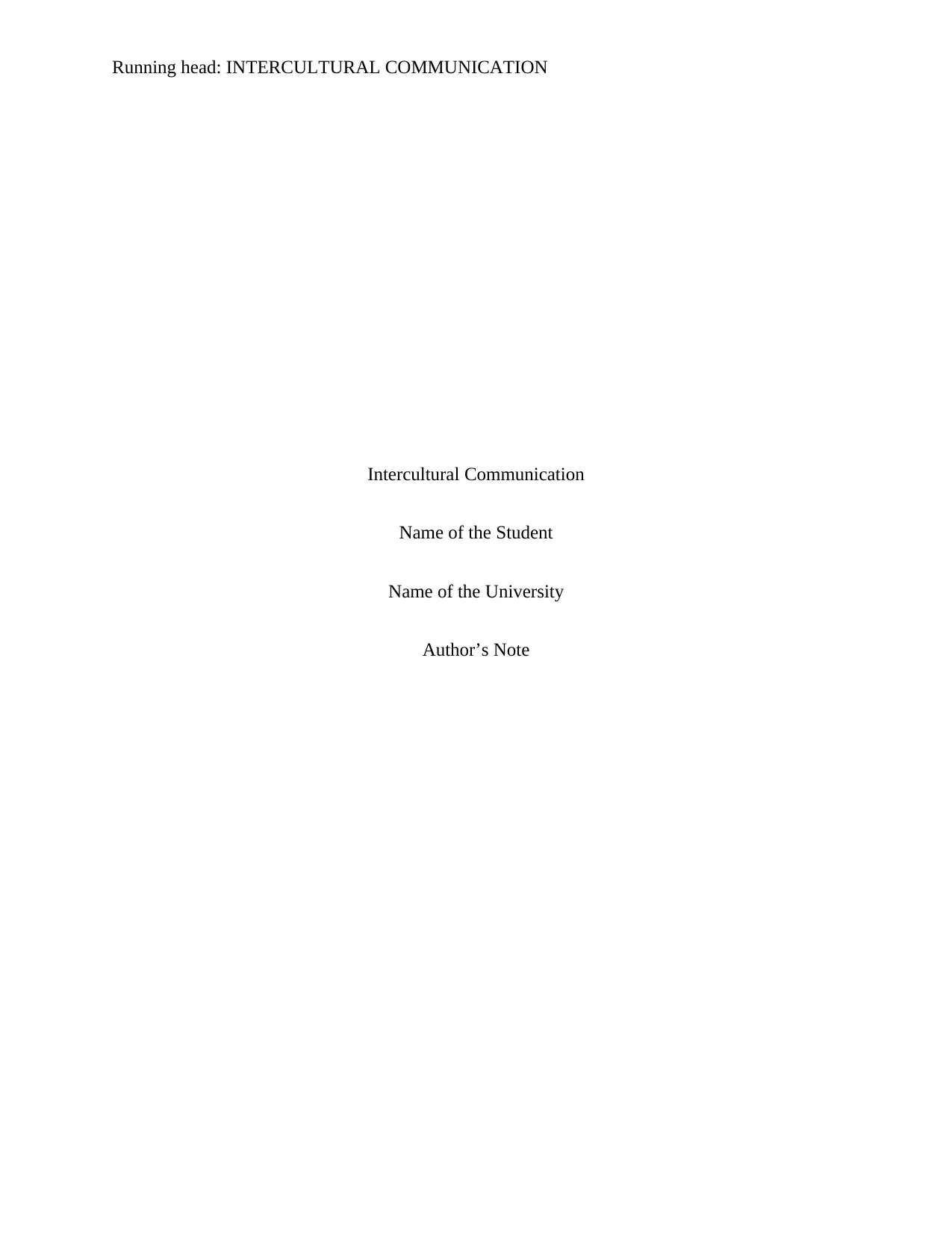
Running head: INTERCULTURAL COMMUNICATION
Intercultural Communication
Name of the Student
Name of the University
Author’s Note
Intercultural Communication
Name of the Student
Name of the University
Author’s Note
Paraphrase This Document
Need a fresh take? Get an instant paraphrase of this document with our AI Paraphraser
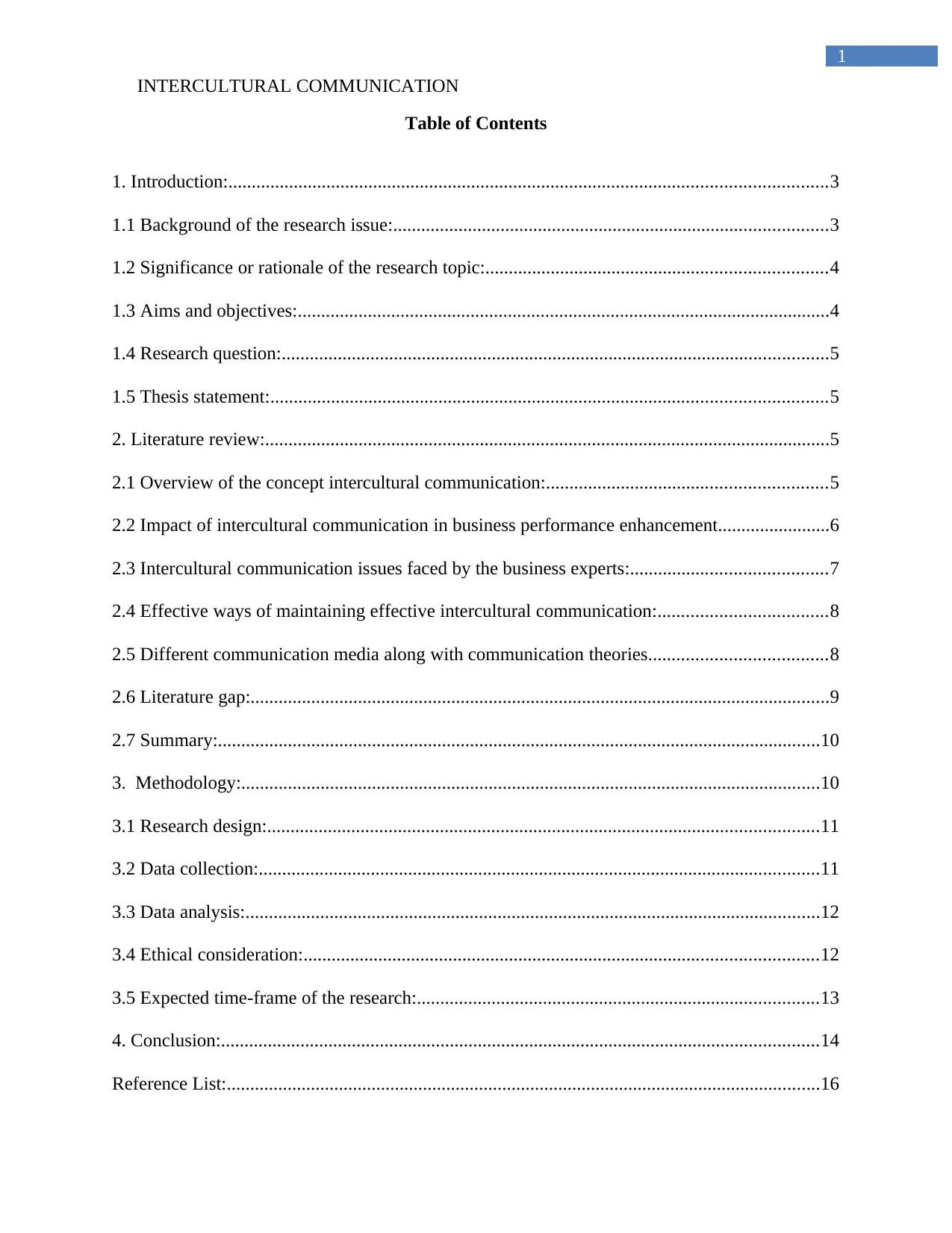
1
INTERCULTURAL COMMUNICATION
Table of Contents
1. Introduction:................................................................................................................................3
1.1 Background of the research issue:.............................................................................................3
1.2 Significance or rationale of the research topic:.........................................................................4
1.3 Aims and objectives:..................................................................................................................4
1.4 Research question:.....................................................................................................................5
1.5 Thesis statement:.......................................................................................................................5
2. Literature review:.........................................................................................................................5
2.1 Overview of the concept intercultural communication:............................................................5
2.2 Impact of intercultural communication in business performance enhancement........................6
2.3 Intercultural communication issues faced by the business experts:..........................................7
2.4 Effective ways of maintaining effective intercultural communication:....................................8
2.5 Different communication media along with communication theories......................................8
2.6 Literature gap:............................................................................................................................9
2.7 Summary:.................................................................................................................................10
3. Methodology:............................................................................................................................10
3.1 Research design:......................................................................................................................11
3.2 Data collection:........................................................................................................................11
3.3 Data analysis:...........................................................................................................................12
3.4 Ethical consideration:..............................................................................................................12
3.5 Expected time-frame of the research:......................................................................................13
4. Conclusion:................................................................................................................................14
Reference List:...............................................................................................................................16
INTERCULTURAL COMMUNICATION
Table of Contents
1. Introduction:................................................................................................................................3
1.1 Background of the research issue:.............................................................................................3
1.2 Significance or rationale of the research topic:.........................................................................4
1.3 Aims and objectives:..................................................................................................................4
1.4 Research question:.....................................................................................................................5
1.5 Thesis statement:.......................................................................................................................5
2. Literature review:.........................................................................................................................5
2.1 Overview of the concept intercultural communication:............................................................5
2.2 Impact of intercultural communication in business performance enhancement........................6
2.3 Intercultural communication issues faced by the business experts:..........................................7
2.4 Effective ways of maintaining effective intercultural communication:....................................8
2.5 Different communication media along with communication theories......................................8
2.6 Literature gap:............................................................................................................................9
2.7 Summary:.................................................................................................................................10
3. Methodology:............................................................................................................................10
3.1 Research design:......................................................................................................................11
3.2 Data collection:........................................................................................................................11
3.3 Data analysis:...........................................................................................................................12
3.4 Ethical consideration:..............................................................................................................12
3.5 Expected time-frame of the research:......................................................................................13
4. Conclusion:................................................................................................................................14
Reference List:...............................................................................................................................16

2
INTERCULTURAL COMMUNICATION
Research topic: Impact of intercultural communication in business performance
enhancement
1. Introduction:
Business enhancement without proper communication can never reach the peak of its
success. Without maintaining a proper communication, the stakeholders associated with the
organization cannot perform well as per the needs and demands of customers. Communication in
business industry is no longer confined within a specific community or group of people. A
business organization is constituted with the people of various geographical backgrounds and
attitudes having different cultural and religious dignity. In order to build a good rapport with all
the associated stakeholders and meet customers’ needs and demands the business experts have to
focus on maintaining strong intercultural communication on the workplace.
1.1 Background of the research issue:
After evaluating the data of global business scenario in last five years especially in retail
industry, it has been observed that business experts failed to maintain proper communication
with each other. The business industry tends to hire people from cross-cultural backgrounds. The
employees are recruited as per their skills and competency rather than focusing on their cultural
backgrounds and attitudes (Samovar et al., 2014). In this kind of situation, the stakeholders have
to face language barrier, cultural barrier and psychological barrier and so on. Lack of effective
inter-cultural communication is affecting the business process for expanding in the international
market properly. The business managers also are facing immense challenges in taking effective
decision. Therefore, numerous research scholars and practitioners have showed their major
INTERCULTURAL COMMUNICATION
Research topic: Impact of intercultural communication in business performance
enhancement
1. Introduction:
Business enhancement without proper communication can never reach the peak of its
success. Without maintaining a proper communication, the stakeholders associated with the
organization cannot perform well as per the needs and demands of customers. Communication in
business industry is no longer confined within a specific community or group of people. A
business organization is constituted with the people of various geographical backgrounds and
attitudes having different cultural and religious dignity. In order to build a good rapport with all
the associated stakeholders and meet customers’ needs and demands the business experts have to
focus on maintaining strong intercultural communication on the workplace.
1.1 Background of the research issue:
After evaluating the data of global business scenario in last five years especially in retail
industry, it has been observed that business experts failed to maintain proper communication
with each other. The business industry tends to hire people from cross-cultural backgrounds. The
employees are recruited as per their skills and competency rather than focusing on their cultural
backgrounds and attitudes (Samovar et al., 2014). In this kind of situation, the stakeholders have
to face language barrier, cultural barrier and psychological barrier and so on. Lack of effective
inter-cultural communication is affecting the business process for expanding in the international
market properly. The business managers also are facing immense challenges in taking effective
decision. Therefore, numerous research scholars and practitioners have showed their major
⊘ This is a preview!⊘
Do you want full access?
Subscribe today to unlock all pages.

Trusted by 1+ million students worldwide
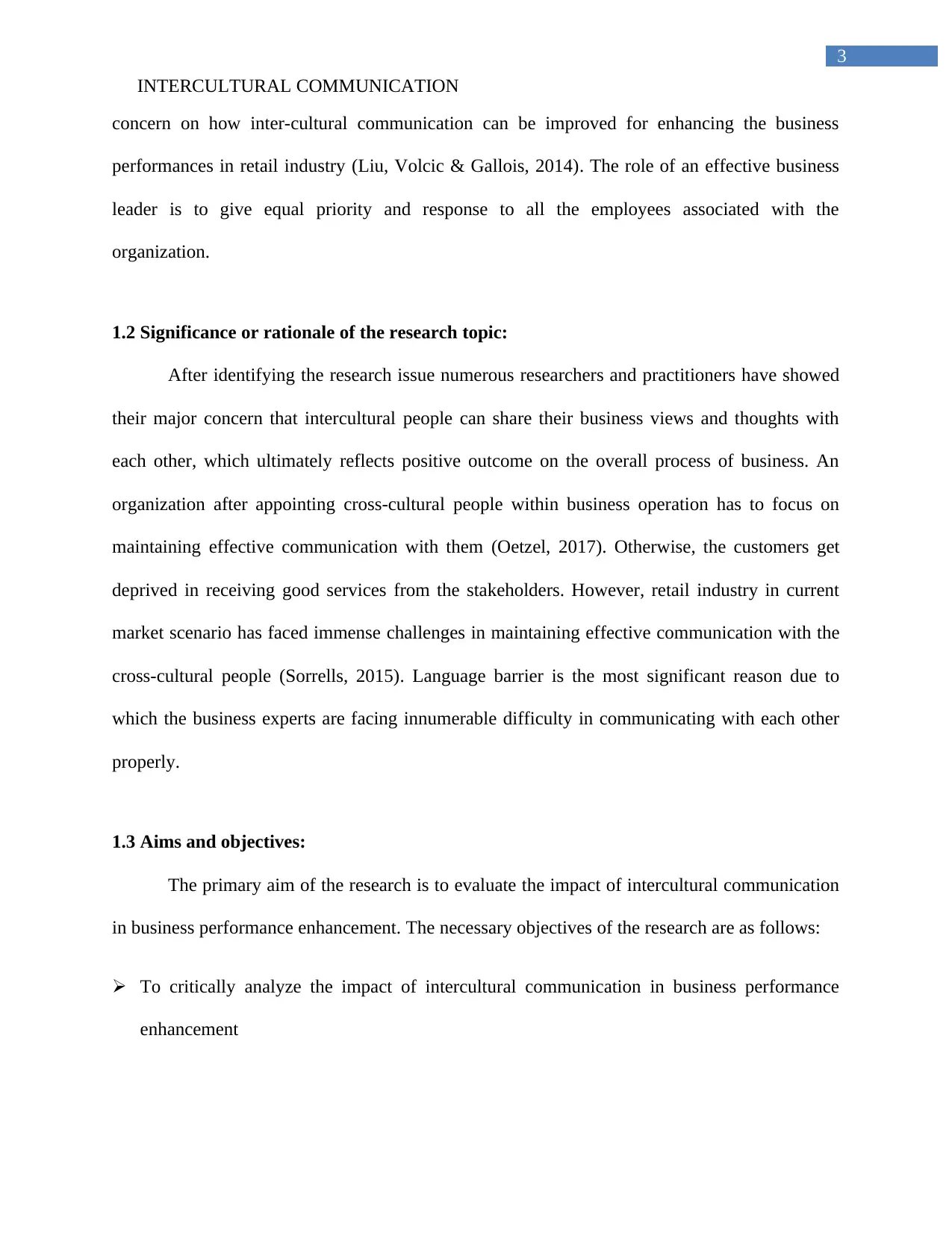
3
INTERCULTURAL COMMUNICATION
concern on how inter-cultural communication can be improved for enhancing the business
performances in retail industry (Liu, Volcic & Gallois, 2014). The role of an effective business
leader is to give equal priority and response to all the employees associated with the
organization.
1.2 Significance or rationale of the research topic:
After identifying the research issue numerous researchers and practitioners have showed
their major concern that intercultural people can share their business views and thoughts with
each other, which ultimately reflects positive outcome on the overall process of business. An
organization after appointing cross-cultural people within business operation has to focus on
maintaining effective communication with them (Oetzel, 2017). Otherwise, the customers get
deprived in receiving good services from the stakeholders. However, retail industry in current
market scenario has faced immense challenges in maintaining effective communication with the
cross-cultural people (Sorrells, 2015). Language barrier is the most significant reason due to
which the business experts are facing innumerable difficulty in communicating with each other
properly.
1.3 Aims and objectives:
The primary aim of the research is to evaluate the impact of intercultural communication
in business performance enhancement. The necessary objectives of the research are as follows:
To critically analyze the impact of intercultural communication in business performance
enhancement
INTERCULTURAL COMMUNICATION
concern on how inter-cultural communication can be improved for enhancing the business
performances in retail industry (Liu, Volcic & Gallois, 2014). The role of an effective business
leader is to give equal priority and response to all the employees associated with the
organization.
1.2 Significance or rationale of the research topic:
After identifying the research issue numerous researchers and practitioners have showed
their major concern that intercultural people can share their business views and thoughts with
each other, which ultimately reflects positive outcome on the overall process of business. An
organization after appointing cross-cultural people within business operation has to focus on
maintaining effective communication with them (Oetzel, 2017). Otherwise, the customers get
deprived in receiving good services from the stakeholders. However, retail industry in current
market scenario has faced immense challenges in maintaining effective communication with the
cross-cultural people (Sorrells, 2015). Language barrier is the most significant reason due to
which the business experts are facing innumerable difficulty in communicating with each other
properly.
1.3 Aims and objectives:
The primary aim of the research is to evaluate the impact of intercultural communication
in business performance enhancement. The necessary objectives of the research are as follows:
To critically analyze the impact of intercultural communication in business performance
enhancement
Paraphrase This Document
Need a fresh take? Get an instant paraphrase of this document with our AI Paraphraser
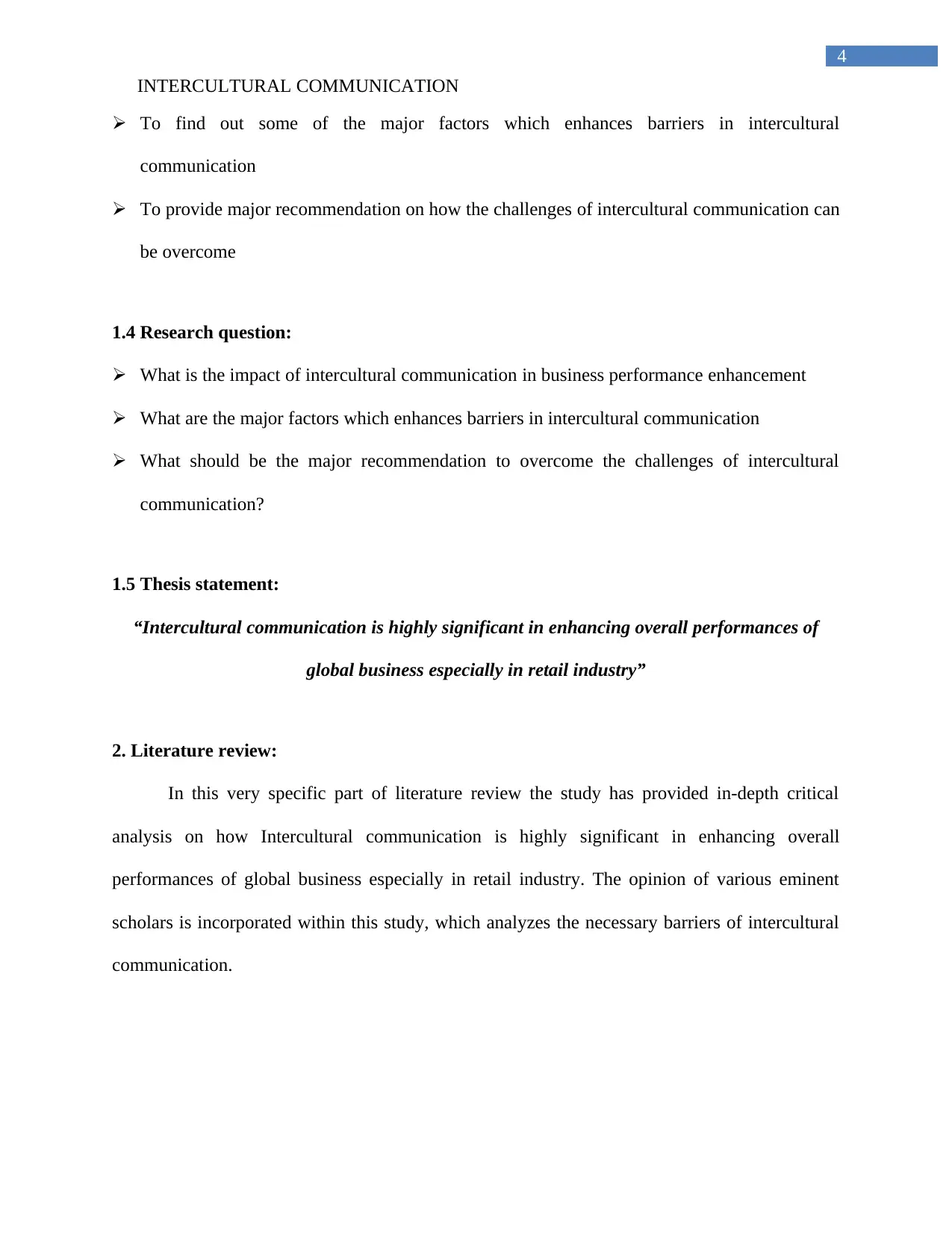
4
INTERCULTURAL COMMUNICATION
To find out some of the major factors which enhances barriers in intercultural
communication
To provide major recommendation on how the challenges of intercultural communication can
be overcome
1.4 Research question:
What is the impact of intercultural communication in business performance enhancement
What are the major factors which enhances barriers in intercultural communication
What should be the major recommendation to overcome the challenges of intercultural
communication?
1.5 Thesis statement:
“Intercultural communication is highly significant in enhancing overall performances of
global business especially in retail industry”
2. Literature review:
In this very specific part of literature review the study has provided in-depth critical
analysis on how Intercultural communication is highly significant in enhancing overall
performances of global business especially in retail industry. The opinion of various eminent
scholars is incorporated within this study, which analyzes the necessary barriers of intercultural
communication.
INTERCULTURAL COMMUNICATION
To find out some of the major factors which enhances barriers in intercultural
communication
To provide major recommendation on how the challenges of intercultural communication can
be overcome
1.4 Research question:
What is the impact of intercultural communication in business performance enhancement
What are the major factors which enhances barriers in intercultural communication
What should be the major recommendation to overcome the challenges of intercultural
communication?
1.5 Thesis statement:
“Intercultural communication is highly significant in enhancing overall performances of
global business especially in retail industry”
2. Literature review:
In this very specific part of literature review the study has provided in-depth critical
analysis on how Intercultural communication is highly significant in enhancing overall
performances of global business especially in retail industry. The opinion of various eminent
scholars is incorporated within this study, which analyzes the necessary barriers of intercultural
communication.

5
INTERCULTURAL COMMUNICATION
2.1 Overview of the concept intercultural communication:
Brannen, Piekkari and Tietze (2017) commented that intercultural communication is
otherwise named as a discipline, which enables the business experts in maintaining proper
interaction among the people of cross-cultural backgrounds. A business organization is
constituted with the people of various cultural and religious backgrounds. Therefore, the business
managers have to render multi-lingual and multi-behavioural flexibility with the help of which
employees of various backgrounds can maintain effective rapport in the workplace. On the other
hand, business organizations have to deal with the customers of cross-cultural backgrounds as
well. Martin and Nakayama (2015) sated that the business experts have to get accustomed with
multi-lingual flexibility so that customers do not have to get hesitated in communicating with the
service providers. Especially, in the retail industry it has been observed that both internal as well
as external stakeholders are from numerous backgrounds and psychological attitudes. In this kind
of business environment, the managers as well as associated stakeholders have to show their
liberal attitude in communicating with every individual equally. Otherwise, the business experts
and the internal stakeholders can exchange their views and thoughts with each other. Pikhart
(2014) commented that effective intercultural communication enables the business experts in
maintaining collaborative decision regarding the success of business. In addition, employees as
well get motivation in providing their best services towards the customers.
2.2 Impact of intercultural communication in business performance enhancement
Jenifer and Raman (2015) opined that intercultural communication leaves major positive
impact in enhancing the overall performances of organizations. In case of retail industry, it has
been observed that large number of employees is there who belong to cross cultural
backgrounds. Business experts have to face major difficulties in communicating with those
INTERCULTURAL COMMUNICATION
2.1 Overview of the concept intercultural communication:
Brannen, Piekkari and Tietze (2017) commented that intercultural communication is
otherwise named as a discipline, which enables the business experts in maintaining proper
interaction among the people of cross-cultural backgrounds. A business organization is
constituted with the people of various cultural and religious backgrounds. Therefore, the business
managers have to render multi-lingual and multi-behavioural flexibility with the help of which
employees of various backgrounds can maintain effective rapport in the workplace. On the other
hand, business organizations have to deal with the customers of cross-cultural backgrounds as
well. Martin and Nakayama (2015) sated that the business experts have to get accustomed with
multi-lingual flexibility so that customers do not have to get hesitated in communicating with the
service providers. Especially, in the retail industry it has been observed that both internal as well
as external stakeholders are from numerous backgrounds and psychological attitudes. In this kind
of business environment, the managers as well as associated stakeholders have to show their
liberal attitude in communicating with every individual equally. Otherwise, the business experts
and the internal stakeholders can exchange their views and thoughts with each other. Pikhart
(2014) commented that effective intercultural communication enables the business experts in
maintaining collaborative decision regarding the success of business. In addition, employees as
well get motivation in providing their best services towards the customers.
2.2 Impact of intercultural communication in business performance enhancement
Jenifer and Raman (2015) opined that intercultural communication leaves major positive
impact in enhancing the overall performances of organizations. In case of retail industry, it has
been observed that large number of employees is there who belong to cross cultural
backgrounds. Business experts have to face major difficulties in communicating with those
⊘ This is a preview!⊘
Do you want full access?
Subscribe today to unlock all pages.

Trusted by 1+ million students worldwide
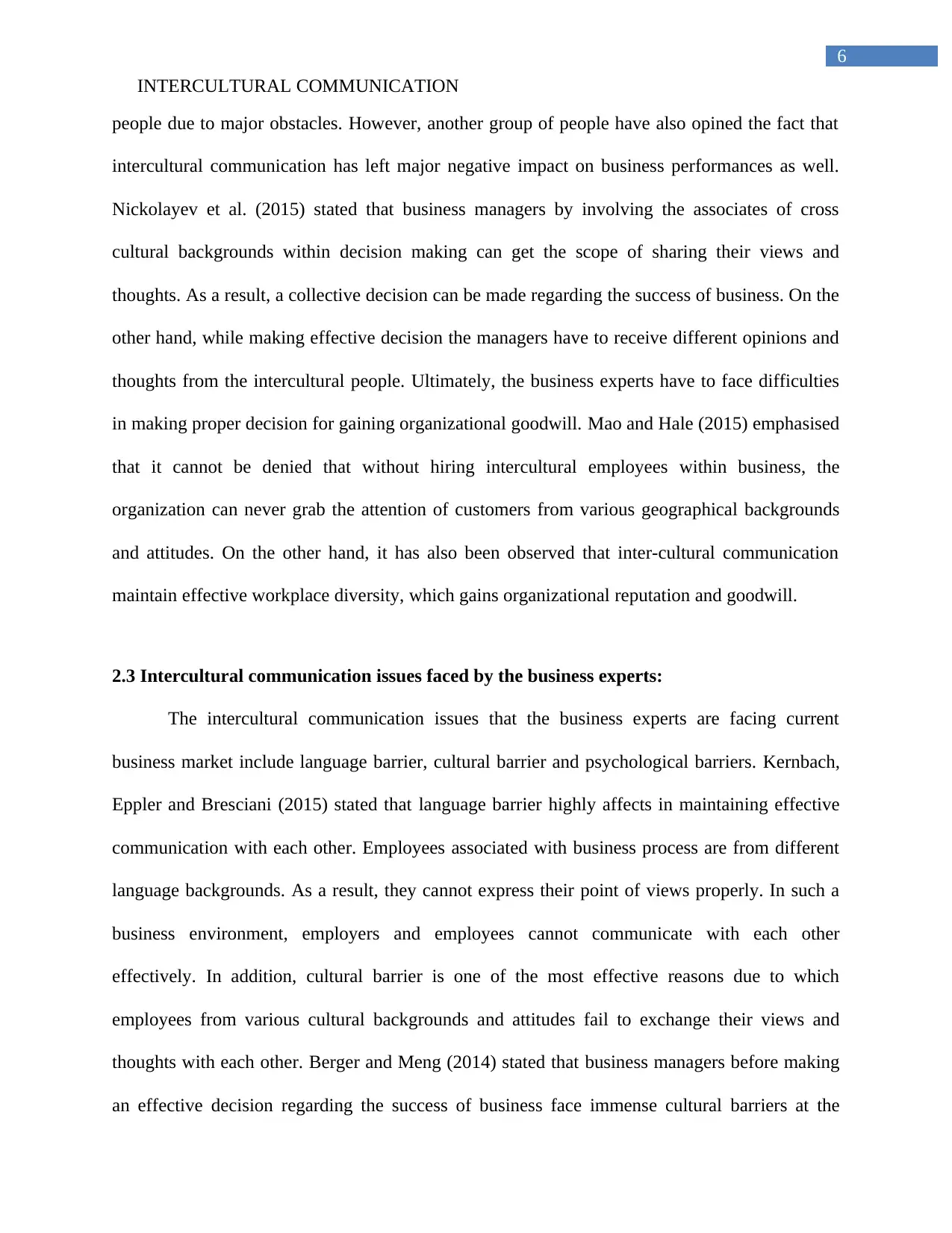
6
INTERCULTURAL COMMUNICATION
people due to major obstacles. However, another group of people have also opined the fact that
intercultural communication has left major negative impact on business performances as well.
Nickolayev et al. (2015) stated that business managers by involving the associates of cross
cultural backgrounds within decision making can get the scope of sharing their views and
thoughts. As a result, a collective decision can be made regarding the success of business. On the
other hand, while making effective decision the managers have to receive different opinions and
thoughts from the intercultural people. Ultimately, the business experts have to face difficulties
in making proper decision for gaining organizational goodwill. Mao and Hale (2015) emphasised
that it cannot be denied that without hiring intercultural employees within business, the
organization can never grab the attention of customers from various geographical backgrounds
and attitudes. On the other hand, it has also been observed that inter-cultural communication
maintain effective workplace diversity, which gains organizational reputation and goodwill.
2.3 Intercultural communication issues faced by the business experts:
The intercultural communication issues that the business experts are facing current
business market include language barrier, cultural barrier and psychological barriers. Kernbach,
Eppler and Bresciani (2015) stated that language barrier highly affects in maintaining effective
communication with each other. Employees associated with business process are from different
language backgrounds. As a result, they cannot express their point of views properly. In such a
business environment, employers and employees cannot communicate with each other
effectively. In addition, cultural barrier is one of the most effective reasons due to which
employees from various cultural backgrounds and attitudes fail to exchange their views and
thoughts with each other. Berger and Meng (2014) stated that business managers before making
an effective decision regarding the success of business face immense cultural barriers at the
INTERCULTURAL COMMUNICATION
people due to major obstacles. However, another group of people have also opined the fact that
intercultural communication has left major negative impact on business performances as well.
Nickolayev et al. (2015) stated that business managers by involving the associates of cross
cultural backgrounds within decision making can get the scope of sharing their views and
thoughts. As a result, a collective decision can be made regarding the success of business. On the
other hand, while making effective decision the managers have to receive different opinions and
thoughts from the intercultural people. Ultimately, the business experts have to face difficulties
in making proper decision for gaining organizational goodwill. Mao and Hale (2015) emphasised
that it cannot be denied that without hiring intercultural employees within business, the
organization can never grab the attention of customers from various geographical backgrounds
and attitudes. On the other hand, it has also been observed that inter-cultural communication
maintain effective workplace diversity, which gains organizational reputation and goodwill.
2.3 Intercultural communication issues faced by the business experts:
The intercultural communication issues that the business experts are facing current
business market include language barrier, cultural barrier and psychological barriers. Kernbach,
Eppler and Bresciani (2015) stated that language barrier highly affects in maintaining effective
communication with each other. Employees associated with business process are from different
language backgrounds. As a result, they cannot express their point of views properly. In such a
business environment, employers and employees cannot communicate with each other
effectively. In addition, cultural barrier is one of the most effective reasons due to which
employees from various cultural backgrounds and attitudes fail to exchange their views and
thoughts with each other. Berger and Meng (2014) stated that business managers before making
an effective decision regarding the success of business face immense cultural barriers at the
Paraphrase This Document
Need a fresh take? Get an instant paraphrase of this document with our AI Paraphraser

7
INTERCULTURAL COMMUNICATION
workplace. People from different psychological backgrounds and attitudes are associated with
the business organization. In being associated with such a business environment, managers have
to receive opinions of different psychologies, beliefs and thoughts. Ultimately, they have to face
difficulties in effective decision-making towards achieving the success of business.
2.4 Effective ways of maintaining effective intercultural communication:
Sozinova et al. (2016) commented that Verbal communication nonverbal communication
is two most effective ways of maintaining effective intercultural communication. People who
have language barrier can follow non-verbal communication method with the help of which
conversation can be continued properly. With the help of written communication techniques, the
business experts can transmit necessary information equally to all the concerned stakeholders.
People having issues with the information can revert their feedback through email or social
media platform. As a result, an unbiased professional decision can be made properly which
ultimately reflects in organizational productivity and business reputation.
Pudelko, Tenzer and Harzing (2015) opined that the business experts can make
participative form of environment at the workplace with the help of which both the
organizational experts and the intercultural employees can communicate with each other
effective. In this democratic form of organizational culture, employees share their views and
thoughts to the concerned manager. As a result, both the employer and the employees intend to
work in a collaborative way.
INTERCULTURAL COMMUNICATION
workplace. People from different psychological backgrounds and attitudes are associated with
the business organization. In being associated with such a business environment, managers have
to receive opinions of different psychologies, beliefs and thoughts. Ultimately, they have to face
difficulties in effective decision-making towards achieving the success of business.
2.4 Effective ways of maintaining effective intercultural communication:
Sozinova et al. (2016) commented that Verbal communication nonverbal communication
is two most effective ways of maintaining effective intercultural communication. People who
have language barrier can follow non-verbal communication method with the help of which
conversation can be continued properly. With the help of written communication techniques, the
business experts can transmit necessary information equally to all the concerned stakeholders.
People having issues with the information can revert their feedback through email or social
media platform. As a result, an unbiased professional decision can be made properly which
ultimately reflects in organizational productivity and business reputation.
Pudelko, Tenzer and Harzing (2015) opined that the business experts can make
participative form of environment at the workplace with the help of which both the
organizational experts and the intercultural employees can communicate with each other
effective. In this democratic form of organizational culture, employees share their views and
thoughts to the concerned manager. As a result, both the employer and the employees intend to
work in a collaborative way.

8
INTERCULTURAL COMMUNICATION
2.5 Different communication media along with communication theories
In a business environment, email and telephonic communication methods are considered
as one of the most effective platforms based on which employees of intercultural backgrounds
can be connected effectively within workplace. Barki et al. (2015) stated that on the other hand,
social media communication is also considered as one of the most effective methods of
connecting people of various geographical backgrounds as well as cultural attributes. Social
media communication can grab the attention of international customers as well. Business experts
can gain in-depth knowledge and experience about their market needs and demands. Based on
their needs and demands, the business experts tend to gather data on how they should enhance
their product diversification as well as market penetration.
As one of the most effective communication models, the model of Shannon and weaver
is one of the most significant models. Aritz and Walker (2014) opined that sender tends to
transmit the message with the help of a proper channel to the decoder in quest of reaching the
information to concerned receiver. Stacks and Salwen (2014) stated that the communication
between sender and receiver will be successful only when the entire transmission of message
becomes convincing to the receiver. In addition, receiver should give an effective feedback to the
concerned sender. As a result, entire business communication becomes successful. Lawrence
(2015) opined that this particular model should be implemented at workplace so that employees
associated with the business process can maintain effective communication with each other in
order to render business success.
INTERCULTURAL COMMUNICATION
2.5 Different communication media along with communication theories
In a business environment, email and telephonic communication methods are considered
as one of the most effective platforms based on which employees of intercultural backgrounds
can be connected effectively within workplace. Barki et al. (2015) stated that on the other hand,
social media communication is also considered as one of the most effective methods of
connecting people of various geographical backgrounds as well as cultural attributes. Social
media communication can grab the attention of international customers as well. Business experts
can gain in-depth knowledge and experience about their market needs and demands. Based on
their needs and demands, the business experts tend to gather data on how they should enhance
their product diversification as well as market penetration.
As one of the most effective communication models, the model of Shannon and weaver
is one of the most significant models. Aritz and Walker (2014) opined that sender tends to
transmit the message with the help of a proper channel to the decoder in quest of reaching the
information to concerned receiver. Stacks and Salwen (2014) stated that the communication
between sender and receiver will be successful only when the entire transmission of message
becomes convincing to the receiver. In addition, receiver should give an effective feedback to the
concerned sender. As a result, entire business communication becomes successful. Lawrence
(2015) opined that this particular model should be implemented at workplace so that employees
associated with the business process can maintain effective communication with each other in
order to render business success.
⊘ This is a preview!⊘
Do you want full access?
Subscribe today to unlock all pages.

Trusted by 1+ million students worldwide
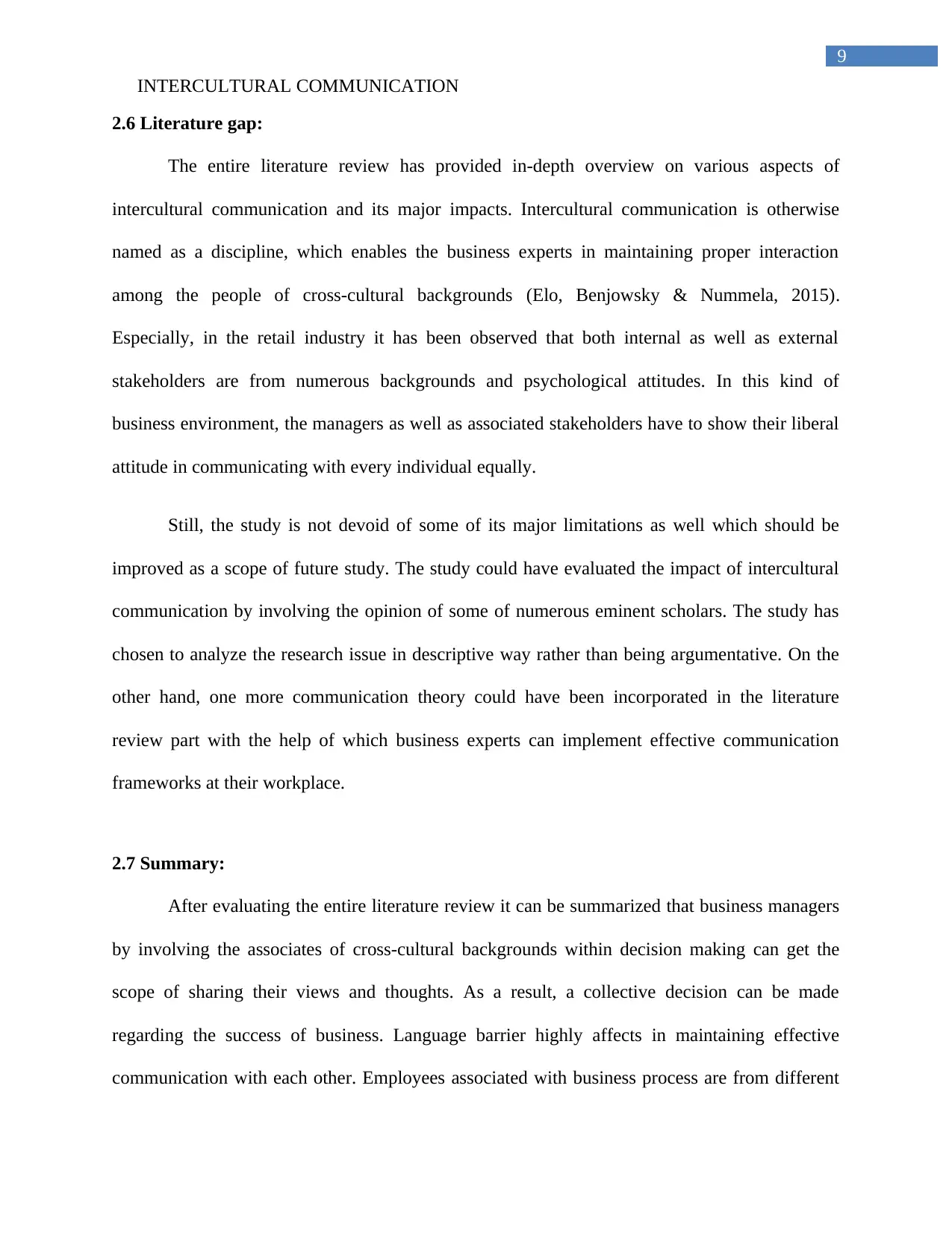
9
INTERCULTURAL COMMUNICATION
2.6 Literature gap:
The entire literature review has provided in-depth overview on various aspects of
intercultural communication and its major impacts. Intercultural communication is otherwise
named as a discipline, which enables the business experts in maintaining proper interaction
among the people of cross-cultural backgrounds (Elo, Benjowsky & Nummela, 2015).
Especially, in the retail industry it has been observed that both internal as well as external
stakeholders are from numerous backgrounds and psychological attitudes. In this kind of
business environment, the managers as well as associated stakeholders have to show their liberal
attitude in communicating with every individual equally.
Still, the study is not devoid of some of its major limitations as well which should be
improved as a scope of future study. The study could have evaluated the impact of intercultural
communication by involving the opinion of some of numerous eminent scholars. The study has
chosen to analyze the research issue in descriptive way rather than being argumentative. On the
other hand, one more communication theory could have been incorporated in the literature
review part with the help of which business experts can implement effective communication
frameworks at their workplace.
2.7 Summary:
After evaluating the entire literature review it can be summarized that business managers
by involving the associates of cross-cultural backgrounds within decision making can get the
scope of sharing their views and thoughts. As a result, a collective decision can be made
regarding the success of business. Language barrier highly affects in maintaining effective
communication with each other. Employees associated with business process are from different
INTERCULTURAL COMMUNICATION
2.6 Literature gap:
The entire literature review has provided in-depth overview on various aspects of
intercultural communication and its major impacts. Intercultural communication is otherwise
named as a discipline, which enables the business experts in maintaining proper interaction
among the people of cross-cultural backgrounds (Elo, Benjowsky & Nummela, 2015).
Especially, in the retail industry it has been observed that both internal as well as external
stakeholders are from numerous backgrounds and psychological attitudes. In this kind of
business environment, the managers as well as associated stakeholders have to show their liberal
attitude in communicating with every individual equally.
Still, the study is not devoid of some of its major limitations as well which should be
improved as a scope of future study. The study could have evaluated the impact of intercultural
communication by involving the opinion of some of numerous eminent scholars. The study has
chosen to analyze the research issue in descriptive way rather than being argumentative. On the
other hand, one more communication theory could have been incorporated in the literature
review part with the help of which business experts can implement effective communication
frameworks at their workplace.
2.7 Summary:
After evaluating the entire literature review it can be summarized that business managers
by involving the associates of cross-cultural backgrounds within decision making can get the
scope of sharing their views and thoughts. As a result, a collective decision can be made
regarding the success of business. Language barrier highly affects in maintaining effective
communication with each other. Employees associated with business process are from different
Paraphrase This Document
Need a fresh take? Get an instant paraphrase of this document with our AI Paraphraser

10
INTERCULTURAL COMMUNICATION
language backgrounds. In being associated with such a business environment, managers have to
receive opinions of different psychologies, beliefs and thoughts. Ultimately, they have to face
difficulties in effective decision-making towards achieving the success of business. Especially, in
the retail industry it has been observed that both internal as well as external stakeholders are
from numerous backgrounds and psychological attitudes.
3. Methodology:
Research methodology primarily implies on how data and information on identified
research issue can be collected by applying reliable and valid resources. The study by using these
appropriate methodological tools would like to gather important information regarding the
impact of intercultural communication in business performance enhancement (Cloutier et al.,
2015). Appropriate data analysis tools and research design will also be used in gathering data
from the various resources.
3.1 Research design:
Research design is the systematic method of organizing collected data and information
from by using different philosophical approaches. With the help of positivism research
philosophy the study would like to make keen observation about the identified research issue. On
the other hand, descriptive research design helps in analyzing collected information without
making any interpretation (Nair-Venugopal, 2015). On the other hand, deductive approach helps
in evaluating the existing case studies and theoretical concepts by exploring effective
information regarding the research identified research issue.
INTERCULTURAL COMMUNICATION
language backgrounds. In being associated with such a business environment, managers have to
receive opinions of different psychologies, beliefs and thoughts. Ultimately, they have to face
difficulties in effective decision-making towards achieving the success of business. Especially, in
the retail industry it has been observed that both internal as well as external stakeholders are
from numerous backgrounds and psychological attitudes.
3. Methodology:
Research methodology primarily implies on how data and information on identified
research issue can be collected by applying reliable and valid resources. The study by using these
appropriate methodological tools would like to gather important information regarding the
impact of intercultural communication in business performance enhancement (Cloutier et al.,
2015). Appropriate data analysis tools and research design will also be used in gathering data
from the various resources.
3.1 Research design:
Research design is the systematic method of organizing collected data and information
from by using different philosophical approaches. With the help of positivism research
philosophy the study would like to make keen observation about the identified research issue. On
the other hand, descriptive research design helps in analyzing collected information without
making any interpretation (Nair-Venugopal, 2015). On the other hand, deductive approach helps
in evaluating the existing case studies and theoretical concepts by exploring effective
information regarding the research identified research issue.

11
INTERCULTURAL COMMUNICATION
3.2 Data collection:
Data collection enables in gathering sufficient information from different sources be it
primary or secondary. Data collection is of two major types. Primary source of data collection
technique enables the researcher in getting direct response from the participants (Tracy, 2012).
On the other hand, secondary source of data collection method helps the researcher in getting in-
depth overview about the research issue from different journals, news articles, magazines and so
many. This very specific study would like to select quantitative form of data collection technique
as well as qualitative data collection technique. By involving 100 employees from inter cultural
backgrounds data will be gathered whether retail industry is maintaining effective
communication or not. On the other hand, 5 supervisors will be collected for providing their
opinion regarding the impact of intercultural communication in business performance
enhancement.
3.3 Data analysis:
Data analysis is the systematic process of analyzing the information by using appropriate
statistical tools. This very specific study would like to follow central tendency method with the
help of which appropriate data and information can be presented in liker chart along with
graphical representation (Collis & Hussey, 2013). As a result, the viewers will understand a clear
result about the research issue. On the other hand, data analysis result also helps the researcher in
understanding the reliability of identified issue. In order to make an inseparable relation between
independent variable and dependent variable the researcher would like to make regression
analysis for this research as well.
INTERCULTURAL COMMUNICATION
3.2 Data collection:
Data collection enables in gathering sufficient information from different sources be it
primary or secondary. Data collection is of two major types. Primary source of data collection
technique enables the researcher in getting direct response from the participants (Tracy, 2012).
On the other hand, secondary source of data collection method helps the researcher in getting in-
depth overview about the research issue from different journals, news articles, magazines and so
many. This very specific study would like to select quantitative form of data collection technique
as well as qualitative data collection technique. By involving 100 employees from inter cultural
backgrounds data will be gathered whether retail industry is maintaining effective
communication or not. On the other hand, 5 supervisors will be collected for providing their
opinion regarding the impact of intercultural communication in business performance
enhancement.
3.3 Data analysis:
Data analysis is the systematic process of analyzing the information by using appropriate
statistical tools. This very specific study would like to follow central tendency method with the
help of which appropriate data and information can be presented in liker chart along with
graphical representation (Collis & Hussey, 2013). As a result, the viewers will understand a clear
result about the research issue. On the other hand, data analysis result also helps the researcher in
understanding the reliability of identified issue. In order to make an inseparable relation between
independent variable and dependent variable the researcher would like to make regression
analysis for this research as well.
⊘ This is a preview!⊘
Do you want full access?
Subscribe today to unlock all pages.

Trusted by 1+ million students worldwide
1 out of 18
Related Documents
Your All-in-One AI-Powered Toolkit for Academic Success.
+13062052269
info@desklib.com
Available 24*7 on WhatsApp / Email
![[object Object]](/_next/static/media/star-bottom.7253800d.svg)
Unlock your academic potential
Copyright © 2020–2025 A2Z Services. All Rights Reserved. Developed and managed by ZUCOL.




